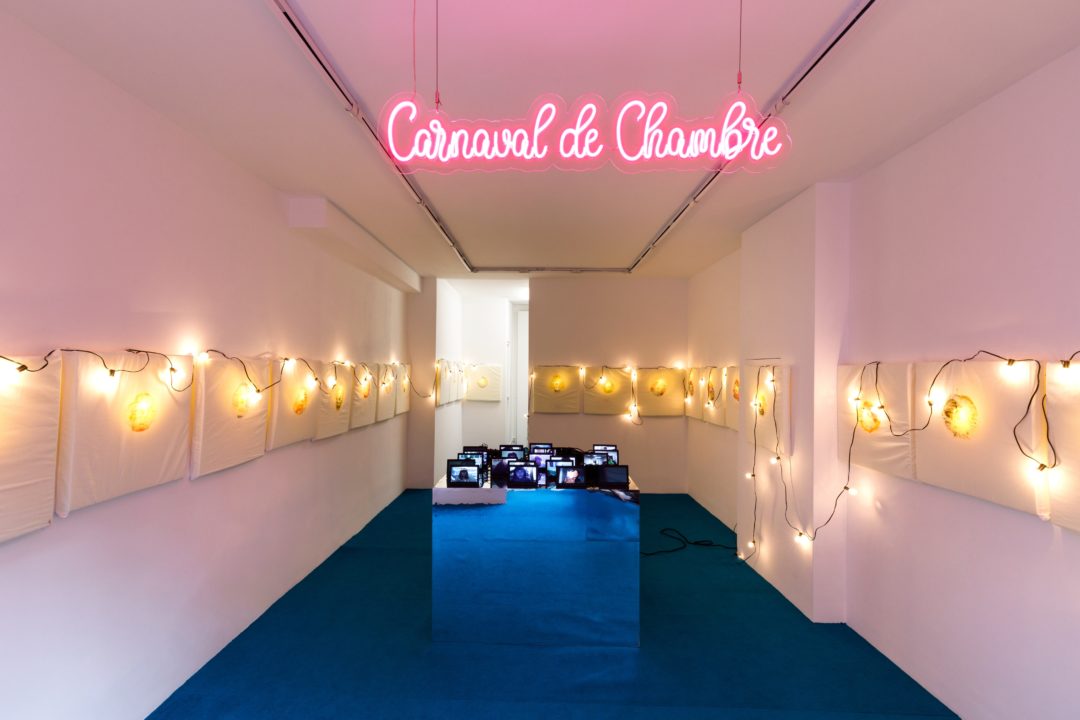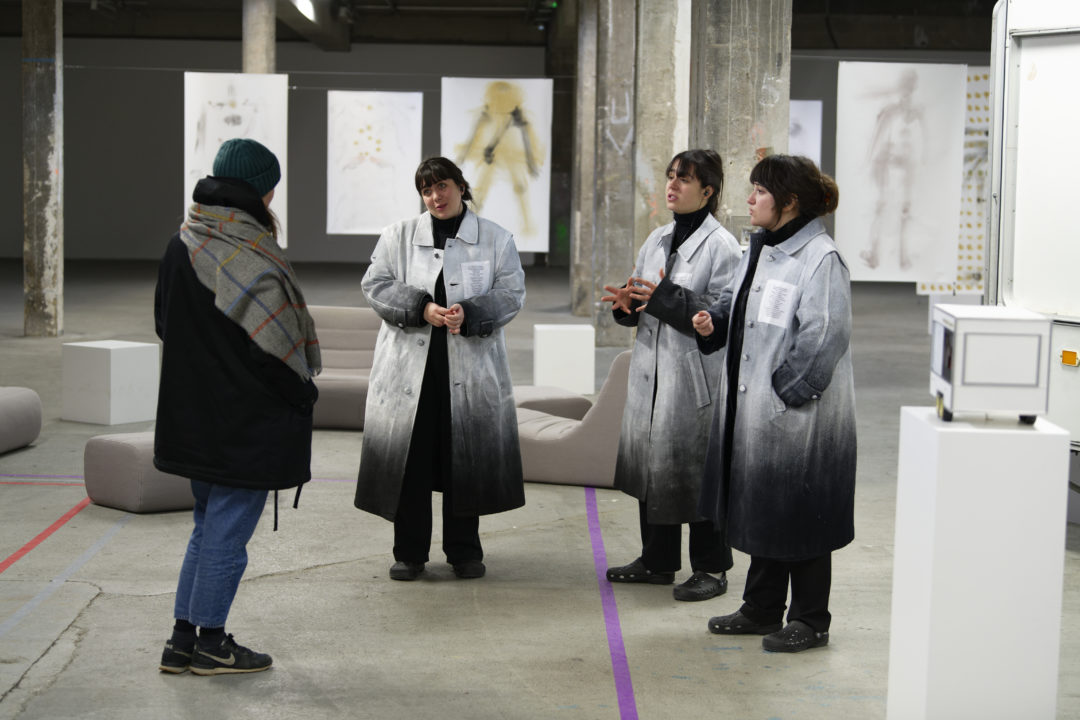To Lose Oneself Without Fear in the Works of Carla Andra

40mcube, Rennes, Palais de Tokyo, Paris, Kunsthalle Mulhouse, Valeria Cetraro Gallery, Paris
Invited by Cell Project Space in London, Swedish artists Josefin Arnell and Max Göran have been working as a duo under the pseudonym HellFun since 2014. However, their exhibition ‘brave and pathetic is better than drowning in shame’ brings their respective artistic practices into dialogue for the first time.
To Lose Oneself Without Fear in the Works of Carla Andra
“What would a thought that is unfamiliar with movement resemble? A thought that walks in place. It would be a thought that wishes for things to be like they had imagined them, an ungenerous thought with regard to the infinite richness of the polysemy of the sensate world,” Jean-Bertrand Pontalis, Crossing the Shadows, Paris, Gallimard, 2003.
FÉV. 2024, 9 MARS, MOI, ÉCRIRE, ADOLESCENCE, ESPION, AMI×ES, SE PERDRE SANS PEUR. (FEB. 2024, 9TH MARCH, ME, WRITE, ADOLESCENCE, SPY, FRIEND(S), TO LOSE ONESELF WITHOUT FEAR.) I make out the hastily scrawled words and short declarations one at a time; written in white chalk on canvas in uppercase letters, they are almost child-like. Among this visual cacophony of terms, verbs, adverbs, common and proper nouns, dates and places are dispersed over the entire flat surface. In the centre of the composition, however, one word distinguishes itself with its yellow colour, lowercase letters as well as the way it is framed: here. The humility of its exceptionality seems to be one clue as to how we might interpret what is playing itself out in this place where I find myself, here.

Carla Adra, exposition personnelle / personal exhibition, « Se perdre sans peur », 40mcube, Rennes, 2024. Courtesy de l’artiste & Galerie Valeria Cetraro. Photo : Margot Montigny.
First of all, here is an adverb which refers to time and to space. I am “here” when I am situated, presently, in this place and at this very moment.[1] Here is therefore the place where I find myself, in front of the work Février 2024, Aubervilliers (February 2024, Aubervilliers) by Carla Andra (b.1993). This pluridisciplinary artist’s practise includes performance, installation, video, drawing and writing. This “image” is a subtle cartography of the artist’s lexicon, of her semantics; its interconnections are made with thin, white lines linking the various bits of information which have been spread out across its surface. To lose oneself without fear is therefore linked with 40mcube and to maps. From there, the ramifications multiply: radio, riga/reading, Arthur Chen, month, write, text, and so on.
Here also refers to the artist’s solo exhibition, “Se perdre sans peur” (To Lose Oneself Without Fear) which was at the 40mcube art centre in Rennes this winter. The exhibition space and its display are also shown in pastel, in the background of the canvas. As we might have guessed from the names of certain cultural institutions, “To Lose Oneself Without Fear” is the meeting point of five exhibitions in which the artist participated in, practically simultaneously.[2] For Carla Adra, this game of associations between words and places opens up a contemplative space; here we find the opportunity to draw out each thread one at a time, in order to apprehend her œuvre and artistic process.

Carla Adra, exposition personnelle / personal exhibition, « Carnaval de Chambre », Galerie Valeria Cetraro, Paris, 2024. Courtesy de l’artiste et Galerie Valeria Cetraro. Photo : Salim Santa Lucia.
I still can remember quite clearly having discovered Carla Andra’s works one year earlier at a dual exhibition with Cécile Noguès, “À qui tu parles” (Who are You Talking To), organised by Valeria Cetraro. In the series ‘Mots de gueule’ (2019) (Big Mouth Words), a poetic force emanate from the short and personal sentences, some of which appear crossed out, written on crumpled-up paper: j’ai peur de parler / parle commaime, je suis lesbienne / de qu’elle fille. (I’m afraid to speak / speak anyway, I’m a lesbian / of which girl). The serious tone of the typewritten confessions and the disarmingly candid simplicity of the phrases, handwritten in blue ink, made for a surprising exchange between these two different forces. Here, the artist was clearly questioning our capacity to understand the Other, as well as the emotional weight this holds for us.

Carla Adra, La Famille du Bureau des Pleurs, 2022.
Performance with Lisa Cesaro, Carla Adra, Caroline Detouchet. Group show « Le Grand Désenvoûtement », Palais de Tokyo, Paris 2022. Courtesy de l’artiste et Galerie Valeria Cetraro. Photo : Aurélien Mole.
Carla Andra focuses on how speech is transmitted; she takes on the role of artist-pedagogue, exploring personal narrative as well as reciprocal experience, in a sensitive and inclusive way. For the artist, psychoanalysis and alternative forms of education represent a concrete approach in the development of processes of listening and authentic dialogue. The personal stories she gathers constitute the raw material of her work. This encounter with the Other is orchestrated within the framework of performative experiments and participatory workshops, during which Carla Andra deftly harnesses these brief moments of confidences, a moment where connections form between individuals, their personal experiences and the physical spaces they inhabit. This sensitive material is then placed within carefully-designed models that transform personal narrative into artworks that resonate with the viewer in profound ways.
The multimedia installation Paroles chaudes (Hot Speech), presented during “Toucher l’insensé” (Approaching Unreason) at the Palais de Tokyo, describes the dialogue between the artist and a group of patients in a medical educational institution. During this collaborative experience, velveteen “mental capes” were made in order to create a symbolic confidential space. Here, speech that has far too often been silenced by dominant voices has become audible once more, it is conferred with the legitimacy it deserves.

Carla Adra, Gantophonie, 2024. Installation sonore, group show « Power Up », La Kunsthalle, Mulhouse, 2024. Curators : Géraldine Gourbe, Fanny Lopez et Sandrine Wymann Courtesy de l’artiste & Galerie Valeria Cetraro. Photo : Emilie Vialet
For the 40mcube exhibition, some twenty or so mental maps unfurled themselves in the space like neural networks, capturing the fugitive essence of the artist’s thought process. Each line sketches out a connection, each word a pathway through an interlacing of sensations, feelings and ideas. At times serving as navigational tools along the meanders of a bubbling spirit, other times autonomous artworks, these objects evoke a poetic cartography, revealing intimate intricacies between individuals, discourse and places. This rhizomic approach, inherited from cognitive psychology and reinvented by the artist, is a reflection of the abundance of thoughts and the associations between ideas which nourish her creative process. Carla Adra allows us a kaleidoscopic view of her inner world, where the spontaneity of expression mixes with the rigor of thought, giving forth a mental landscape in perpetual metamorphosis.
“To Lose Oneself Without Fear” can be thought of as an interface, a transitional zone which records and transmits a multitude of narratives. According to Deleuze and Guattari, “radios and television sets are walls of sound for each household, they mark territories.”[3] Microphones, which have been mounted on sculptural stands and antennae release a brouhaha of sound; the maps are activated with the artist’s recorded voice. The educators, dressed in painted smocks, played an essential role at 40mcube, as their work was assimilated with a performance which formed the basis of this mise-en-scene. By synchronizing several micro-diffusers, they ceaselessly recomposed the ambient symphony. This sound piece thus results in the levelling of registers of public, professional and private discourse. The visitor is also free to appropriate the microphone, in order to diffuse their own story, prolonging the performance in the time and space of the exhibition. Each microphone, each antenna, becomes a vector for expression, an interface between the individual and the collective, between private and public. It is through the liberation of these voices that their subjectivity expresses itself fully.
[1] Claire Marin, Être à sa place, Paris, L’Observatoire, 2022, pp. 141-145.
[2] “Carnaval de Chambre” at Valeria Cetraro Gallery (Paris), “Approaching Unreason” at Palais de Tokyo (Paris), “Power Up, imaginaires techniques et utopies sociales” at Kunsthalle (Mulhouse), and “Revenir du présent, regards croisés sur la scène actuelle” at the Collection Lambert (Avignon).
[3] Gilles Deleuze et Félix Guattari, Capitalisme et schizophrénie 2 : Mille plateaux, Paris, Éditions de minuit, p. 382.
______________________________________________________________________________
Head image : Carla Adra, Ça te colle à la peau, 2023. Film. Courtesy de l’artiste et Galerie Valeria Cetraro.
- From the issue: 108
- Share: ,
- By the same author: Jeremy Deller at Rennes, Daniel Pommereulle and Mathis Altmann at Pasquart, Gaillard & Claude: hybrid objects, fluid forms ,
Related articles
Lyon Biennial
by Patrice Joly
Not Everything is Given, Whitney ISP, New York
by Warren Neidich
Rafaela Lopez at Forum Meyrin
by Guillaume Lasserre

